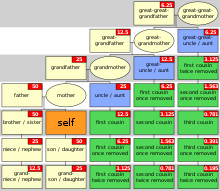Family tree


A family tree, also called a genealogy or a pedigree chart, is a chart representing family relationships in a conventional tree structure. More detailed family trees, used in medicine and social work, are known as genograms.
Representations of family history
Genealogical data can be represented in several formats, for example, as a
together.The passage of time can also be included to illustrate ancestry and descent. A time scale is often used, expanding radially across the center, divided into decades. Children of the parent form branches around the center and their names are plotted in their birth year on the time scale. Spouses' names join children's names and nuclear families of parents and children branch off to grandchildren, and so on. Great-grandparents are often in the center to portray four or five generations, which reflect the natural growth pattern of a tree as seen from the top but sometimes there can be great great grandparents or more. In a descendant tree, living relatives are common on the outer branches and contemporary cousins appear adjacent to each other. Privacy should be considered when preparing a living family tree.[citation needed]
The image of the tree probably originated with that of the
Common formats
In addition to familiar representations of family history and genealogy as a tree structure, there are other notable systems used to illustrate and document ancestry and descent.
Ahnentafel

An
- Subject (or proband)
- Father
- Mother
- Paternal grandfather
- Paternal grandmother
- Maternal grandfather
- Maternal grandmother
and so on, back through the generations. Apart from the subject or proband, who can be male or female, all even-numbered persons are male, and all odd-numbered persons are female. In this scheme, the number of any person's father is double the person's number, and a person's mother is double the person's number plus one. This system can also be displayed as a tree:

| 4. Paternal grandfather | |||||||||||
| 2. Father | |||||||||||
| 5. Paternal grandmother | |||||||||||
| 1 Subject (or proband) | |||||||||||
| 6. Maternal grandfather | |||||||||||
| 3. Mother | |||||||||||
| 7. Maternal grandmother | |||||||||||
Fan chart

A fan chart features a half circle chart with concentric rings: the subject is the inner circle, the second circle is divided in two (each side is one parent), the third circle is divided in four, and so forth. Fan charts depict paternal and maternal ancestors.
Graph theory
While family trees are depicted as trees, family relations do not in general form a
Notable examples

Family trees have been used to document family histories across time and cultures throughout the world.
Africa
In Africa, the
The genealogy of
Elsewhere in Africa,
The Americas
In some pre-contact
East Asia
There are extensive genealogies for the ruling dynasties of China, but these do not form a single, unified family tree. Additionally, it is unclear at which point(s) the most ancient historical figures named become mythological.
In Japan, the ancestry of the
The longest family tree in the world is that of the Chinese philosopher and educator Confucius (551–479 BC), who is descended from King Tang (1675–1646 BC). The tree spans more than 80 generations from him and includes more than 2 million members. An international effort involving more than 450 branches around the world was started in 1998 to retrace and revise this family tree. A new edition of the Confucius genealogy was printed in September 2009 by the Confucius Genealogy Compilation Committee, to coincide with the 2560th anniversary of the birth of the Chinese thinker. This latest edition was expected to include some 1.3 million living members who are scattered around the world today.[6]
Europe and West Asia
Before the
Many noble and aristocratic families of European and West Asian origin can reliably trace their ancestry back as far as the mid to late first millennium AD; some claiming undocumented descent from Classical Antiquity or mythological ancestors. In Europe, for example, the pedigree of
Another very old and extensive tree is that of the
Family trees and representations of lineages are also important in religious traditions. The biblical genealogies of Jesus also claim descent from the House of David, covering a period of approximately 1000 years. In the Torah and Old Testament, genealogies are provided for many biblical persons, including a record of the descendants of Adam. Also according to the Torah, the
Elsewhere
Elsewhere, in many human cultures,
Global
Forms of family trees are also used in
Other uses
The author
Another common use is in the creation of
See also
- GEDCOM
- Genealogical numbering systems
- Genealogy software
- Genogram
- List of family trees
- Pedigree chart
- Tree of life (biology)
- WikiTree
References
- ^ GRENSTAM pp. 490-491
- ^ Simon Julian Gilmour (2000) Daz Sint Noch Ungelogeniu Wort: A Literary and Linguistic Commentary on the Gurnemanz Episode in Book III of Wolfram's Parzival. Universitätsverlag Winter, 2000. p.64
- OCLC 1155486357.
- ^ "Stambomen van de families de Cordes, de Langhe, Bouckaert, Berquyn en Steelant [manuscript]". lib.ugent.be. Retrieved 2020-08-27.
- ^ "What Is A Griot And Why Are They Important". theculturetrip.com. 24 May 2018.
- ^ Confucius family tree has two million members from China Daily, unknown date, updated February 16, 2008
- ISBN 978-1-886223-17-2.
- ^ Bill Gladstone (October 24, 2004). "The oldest family in the world". JTA.
- ^ Guy, Jack. "DNA reveals biggest-ever human family tree, dating back 100,000 years". CNN. Retrieved 10 March 2022.
- ^ Wong, Yan; Wohns, Anthony Wilder. "We're analysing DNA from ancient and modern humans to create a 'family tree of everyone'". Retrieved 21 March 2022.
- S2CID 247106458.
- ^ Amazon – Even More Rock Family trees. ASIN 1844490076.
- ^ "BBC Four : Rock Family Trees". Retrieved 20 September 2012.
External links
 Media related to Family trees at Wikimedia Commons
Media related to Family trees at Wikimedia Commons
